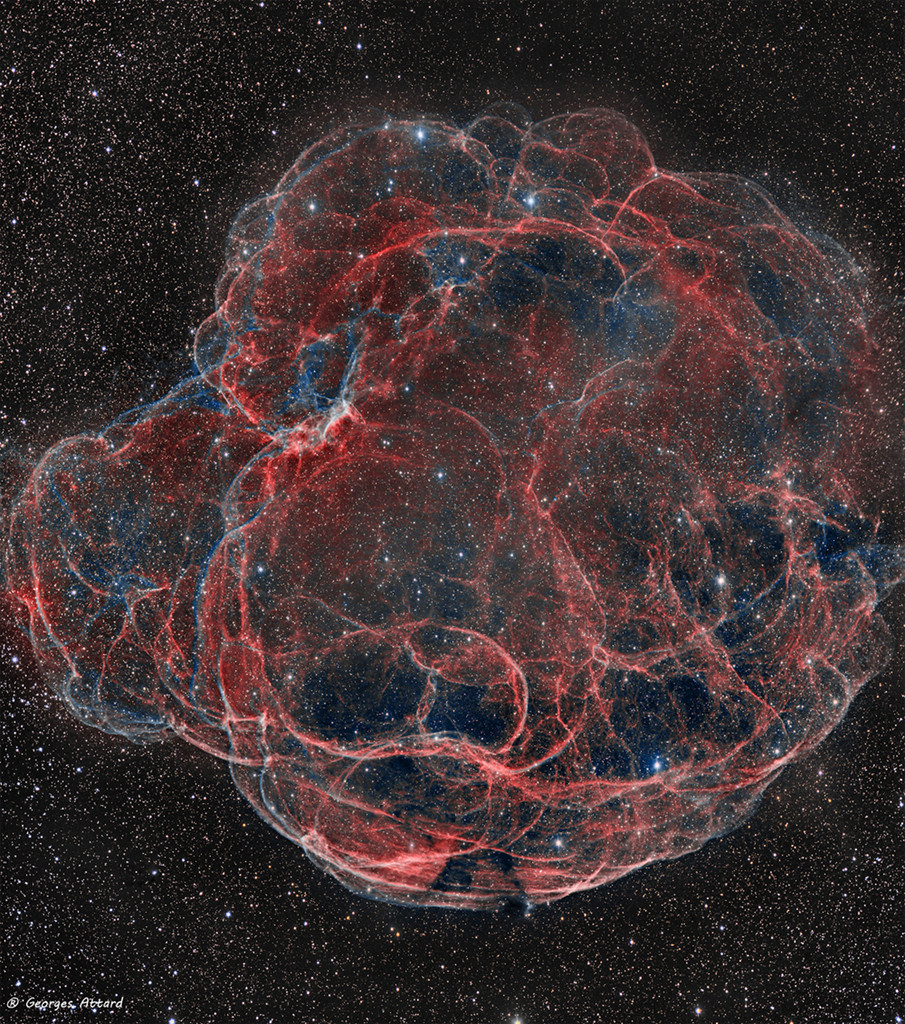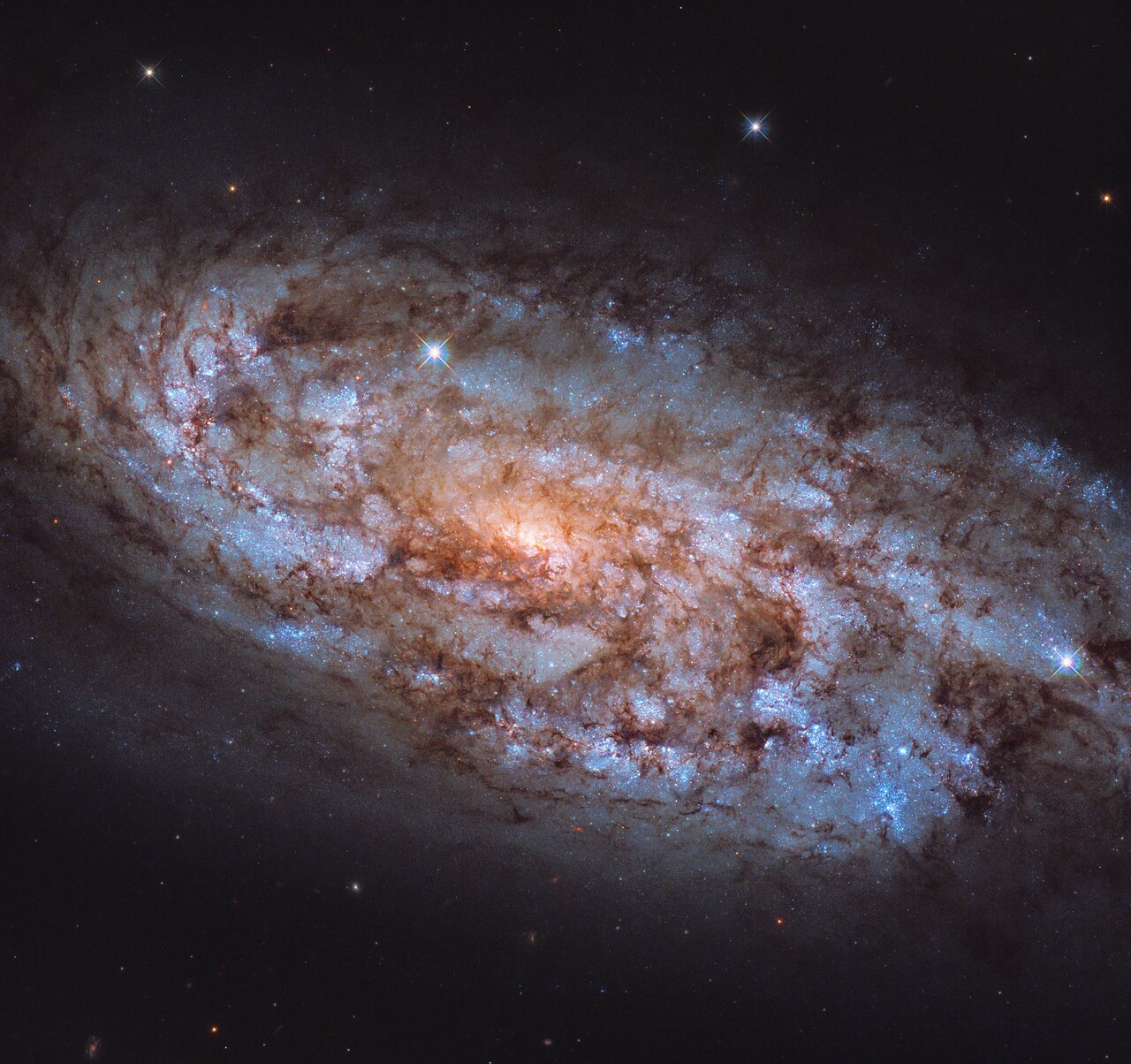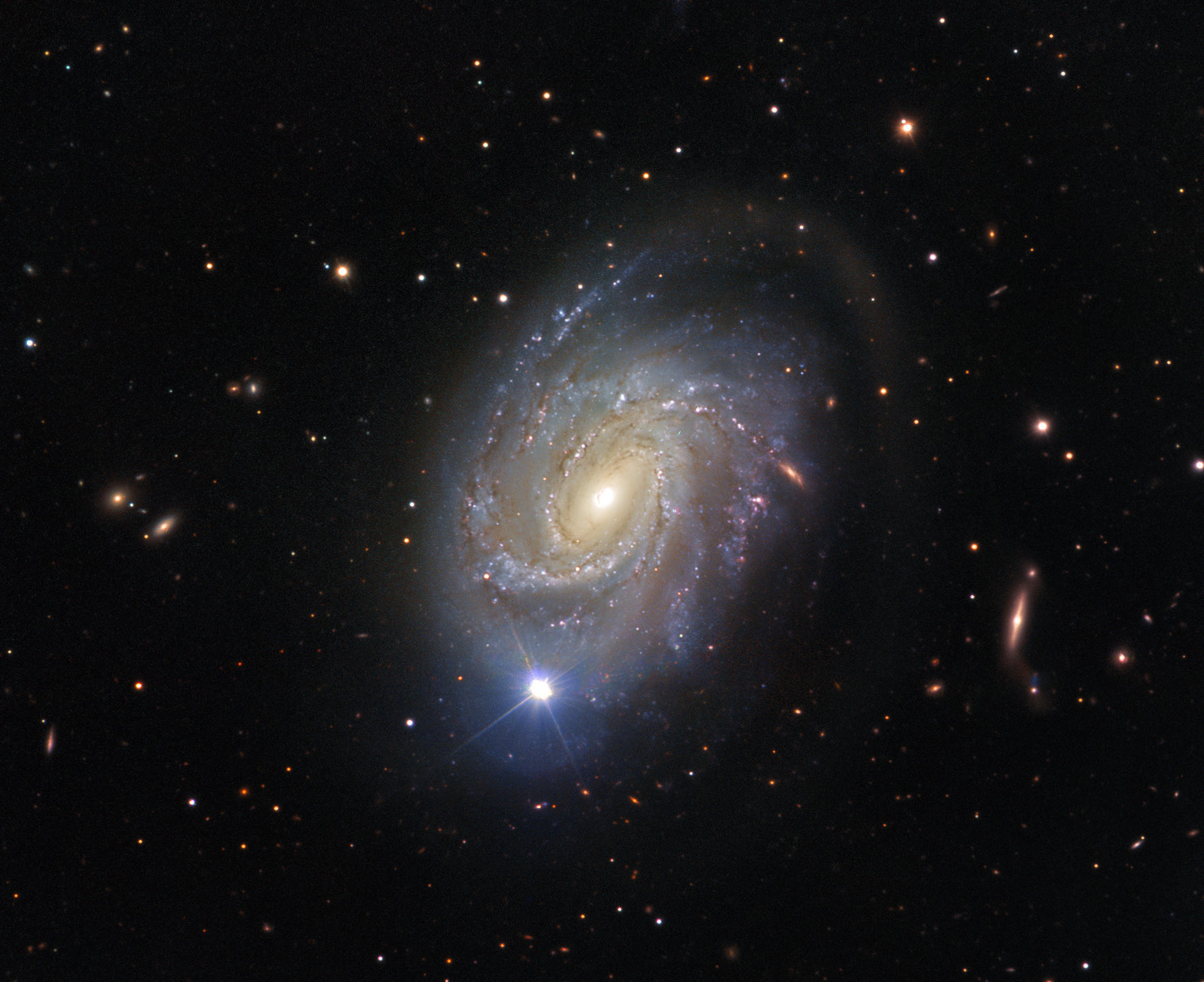Blog
Intricate looping filaments in this detailed image of supernova remnant Simeis 147. Also cataloged as Sharpless 2-240 it goes by the popular nickname, the Spaghetti Nebula.Seen toward the boundary of the constellations Taurus and Auriga, it covers nearly 3 degrees or 6 full moons on the sky. That’s about 150 light-years at the stellar debris cloud’s estimated distance of 3,000 light-years. This composite includes image data taken through narrow-band filters where reddish emission from ionized hydrogen atoms and doubly ionized oxygen atoms in faint blue-green hues trace the shocked, glowing gas. The supernova remnant has an estimated age of about 40,000 years, meaning light from the massive stellar explosion first reached Earth 40,000 years ago. But the expanding remnant is not the only aftermath. The cosmic catastrophe also left behind a spinning neutron star or pulsar, all that remains of the original star’s core.

Pops Mohamed (born Ismail Mohamed-Jan) is a South African multi-instrumentalist, jazz musician and producer.
Born in Benoni, Gauteng Pops Mohamed’s career in music was the logical outcome of an early exposure at Dorkay House to the likes of Abdullah Ibrahim and Kippie Moeketsi. He started his first band The Valiants, at 14. Known by fans as the Minister of Music, he plays a wide variety of instruments: African mouth bow, bird whistle, berimbau, didgeridoo, guitar, keyboard, kora, and the thumb piano. He is also known for his wide range of musical styles which include kwela, pop, and soul. He produced Finding One’s Self, the late Moses Taiwa Molelekwa‘s award-winning album.
Pops has also performed regularly with and sits on the board of the Johannesburg Youth Orchestra Company
more...Eddie Jones (December 10, 1926 – February 7, 1959), better known as Guitar Slim, was a New Orleans blues guitarist in the 1940s and 1950s, best known for the million-selling song “The Things That I Used to Do“, produced by Johnny Vincent for Specialty Records. It is listed in the Rock and Roll Hall of Fame’s 500 Songs That Shaped Rock and Roll. Slim had a major impact on rock and roll and experimented with distorted overtones on the electric guitar a full decade before Jimi Hendrix. Jones was born in Greenwood, Mississippi. His mother died when he was five, and he was raised by his grandmother. In his teen years he worked in cotton fields and spent his free time at juke joints, where he started sitting in as a singer or dancer; he was good enough as a dancer that he was nicknamed “Limber Leg”.
After returning from military service during World War II, he started playing in clubs around New Orleans, Louisiana. Bandleader Willie D. Warrenintroduced him to the guitar. He was particularly influenced by T-Bone Walker and Clarence “Gatemouth” Brown. About 1950 he adopted the stage name Guitar Slim and became known for his wild stage act. He wore bright-colored suits and dyed his hair to match them. He had an assistant who followed him around the audience with up to 350 feet of cord between his guitar and his amplifier, and occasionally rode on his assistant’s shoulders or even took his guitar outside the club, bringing traffic to a stop. His sound was just as unusual—he played his guitar with distortion more than a decade before rock guitarists did, and his gospel-influenced vocals were easily identifiable.
more...Melbourne Robert “Bob” Cranshaw (December 3, 1932 – November 2, 2016) was an American jazz bassist. His career spanned the heyday of Blue Note Records to his recent involvement with the Musicians Union. He is perhaps best known for his long association with Sonny Rollins. Cranshaw performed in Rollins’s working band on and off for over five decades, starting with a live appearance at the 1959 Playboy jazz festival in Chicago and on record with the 1962 album The Bridge.
Cranshaw died at the age of 83 on November 2, 2016 in Manhattan, New York from Stage IV cancer.
more...Ray Willis Nance (December 10, 1913, in Chicago – January 28, 1976, in New York City) was a jazz trumpeter, violinist and singer. He is best remembered for his long association with Duke Ellington and his orchestra.
Nance was the leader of his own band in Chicago from 1932 to 1937. Then, he worked with Earl Hines from 1937 to 1939; and from 1939 to 1940 he worked with Horace Henderson. Ellington hired Nance to replace trumpeter Cootie Williams, who had joined Benny Goodman, in 1940. Nance’s first recorded performance with Ellington was at the Fargo, North Dakota ballroom dance. Shortly after joining the band, Nance was given the trumpet solo on the earliest recorded version of “Take the “A” Train“, which became the Ellington theme. Nance’s “A Train” solo is one of the most copied and admired trumpet solos in jazz history. Indeed, when Cootie Williams returned to the band more than twenty years later, he would play Nance’s solo on “A Train” almost exactly as the original.
https://www.youtube.com/watch?v=gAIibWoTPPU
more...An orange glow radiates from the centre of NGC 1792, the heart of this stellar forge. Captured by the NASA/ESA Hubble Space Telescope, this intimate view of NGC 1792 gives us some insight into this galactic powerhouse. The vast swathes of tell-tale blue seen throughout the galaxy indicate areas that are full of young, hot stars, and it is in the shades of orange, seen nearer the centre, that the older, cooler stars reside. Nestled in the constellation of Columba (The Dove), NGC 1792 is both a spiral galaxy, and a starburst galaxy. Within starburst galaxies, stars are forming at comparatively exorbitant rates. The rate of star formation can be more than 10 times faster in a starburst galaxy than in the Milky Way. When galaxies have a large resevoir of has, like NGC 1792, these short lived starburst phases can be sparked by galactic events such as mergers and tidal interactions. One might think that these starbust galaxies would easily consume all of their gas in our large forming event. However, supernova explosions and intense stellar winds produced in these powerful starbusts can inject energy into the gas and disperse it. This halts the star formation before it can completely deplete the galaxy of all its fuel. Scientists are actively working to understanding this complex interplay between the dynamic that drive and quench these fierce bursts of star formation.

Daniel Ivan Hicks (December 9, 1941 – February 6, 2016) was an American singer-songwriter known for an idiosyncratic style that combined elements of cowboy folk, jazz, country, swing, bluegrass, pop, and gypsy music. He led ″Dan Hicks and His Hot Licks″. He is perhaps best known for the songs “I Scare Myself” and “Canned Music.” His songs are frequently infused with humor, as evidenced by the title of his tune, “How Can I Miss You When You Won’t Go Away?” His album, Live at Davies (2013), capped over forty years of music.
Writing about Hicks for Oxford American in 2007, critic David Smay said, “[T]here was a time from the ’20s through the ’40s when swing—’hot rhythm’—rippled through every form of popular music. That’s the music Dan Hicks plays, and there’s no single word for it because it wasn’t limited to any one genre. Django Reinhardt and the Mills Brothers and Spade Cooley and Hank Garland and the Boswell Sisters and Stuff Smith and Bing Crosby all swing. You can make yourself nutty trying to define what Dan Hicks is. Then again, you could just say: Dan Hicks swings.”
Hicks was born in Little Rock, Arkansas on December 9, 1941. His father, Ivan L. Hicks (married to the former Evelyn Kehl), was a career United States Air Force non-commissioned officer. At age five, an only child, Hicks moved with his family to California. Following brief stints in Lomita, Cambria, and Vallejo, the family settled in Santa Rosa, the largest city in the North Bay subregion of the San Francisco Bay Area, where he was a drummer in grade school and played the snare drum in his school marching band.
more...Junior Wells (born Amos Wells Blakemore Jr., December 9, 1934 – January 15, 1998) was an American Chicago blues vocalist, harmonica player, and recording artist. He was one of the pioneers of the amplified blues harp-style associated with Chicago. Wells is best known for his signature song “Messin’ with the Kid” and his 1965 album Hoodoo Man Blues, described by the critic Bill Dahl as “one of the truly classic blues albums of the 1960s”.
Wells performed and recorded with Various notable blues musicians, including Muddy Waters, Earl Hooker, and Buddy Guy. He remained a fixture on the blues scene throughout his career and also crossed over to rock audiences while touring with the Rolling Stones. Not long before Wells died, the blues historian Gerard Herzhaft called him “one of the rare active survivors of the ‘golden age of the blues'”.
Wells may have been born in Memphis, Tennessee, and raised in West Memphis, Arkansas (some sources report that he was born in West Memphis).Initially taught by his cousin Junior Parker and by Sonny Boy Williamson II, Wells learned to play the harmonica skillfully by the age of seven.
He moved to Chicago in 1948 with his mother, after her divorce, and began sitting in with local musicians at house parties and taverns. Wild and rebellious but needing an outlet for his talents, he began performing with the Aces, consisting of the brothers Dave and Louis Myers on guitars and the drummer Fred Below, with whom he developed a modern amplified harmonica style influenced by Little Walter. In 1952, he made his first recordings when he replaced Little Walter in Muddy Waters’s band and played on one of Waters’s sessions for Chess Records in 1952. His first recordings as a bandleader were made in the following year for States Records. In the late 1950s and early 1960s, he recorded singles for Chief Records and its subsidiary, Profile Records, including “Messin’ with the Kid“, “Come on in This House”, and “It Hurts Me Too“, which would remain in his repertoire throughout his career. His 1960 Profile single “Little by Little” (written by Chief owner and producer Mel London) reached number 23 on the Billboard R&B chart, the first of his two singles to enter the chart.
https://www.youtube.com/watch?v=0KxVtC6AUVc
more...Jessie Hill (December 9, 1932 – September 17, 1996) was an American R&B and Louisiana blues singer and songwriter, best remembered for the classic song “Ooh Poo Pah Doo“.
Hill was born in New Orleans, Louisiana, United States. By his teens he was playing drums in local bands, and in 1951 he formed his own group, the House Rockers. After periods performing as drummer with Professor Longhair and then Huey “Piano” Smith, Hill formed a new version of the House Rockers in 1958, which enabled him to focus on singing with the band.
The origins of “Ooh Poo Pah Doo” were apparently created from a tune played by a local pianist, who was known only as Big Four. Hill wrote the lyricsand melody, later expanding the work with an intro taken from Dave Bartholomew. It was further honed on stage, before Hill recorded a demo that he shopped to local record labels, finally recording a session at Cosimo Matassa‘s studio produced by Allen Toussaint.
Upon its 1960 release on Minit Records, “Ooh Poo Pah Doo” emerged as a favorite at Mardi Gras, selling 800,000 copies and reaching #3 on the Billboard R&B chart and #28 in the Billboard Hot 100 pop chart. There have been over 100 cover versions of “Ooh Poo Pah Doo” recorded and performed live over the years by other popular musicians.
more...Donaldson Toussaint L’Ouverture Byrd II (December 9, 1932 – February 4, 2013) was an American jazz and rhythm & blues trumpeter and vocalist. A sideman for many other jazz musicians of his generation, Byrd was known as one of the rare bebop jazz musicians who successfully explored funk and soul while remaining a jazz artist. As a bandleader, Byrd was an influence on the early career of Herbie Hancock.
Byrd attended Cass Technical High School. He performed with Lionel Hampton before finishing high school. After playing in a military band during a term in the United States Air Force, Byrd obtained a bachelor’s degree in music from Wayne State University and a master’s degree from Manhattan School of Music. While still at the Manhattan School, he joined Art Blakey‘s Jazz Messengers, as the successor to Clifford Brown. In 1955, he recorded with Gigi Gryce, Jackie McLean and Mal Waldron. After leaving the Jazz Messengers in 1956, he performed with many leading jazz musicians of the day, including John Coltrane, Sonny Rollins, Thelonious Monk, and later Herbie Hancock.
Byrd’s first regular group was a quintet that he co-led from 1958 to 1961 with baritone saxophonist Pepper Adams, an ensemble whose hard-driving performances are captured “live” on At the Half Note Cafe.
more...https://www.youtube.com/watch?v=xudZfecDbLU
more...Jason Haber videoed the crowd singing Dear Prudence.
Over 75 million light-years away in the constellation of Virgo (The Virgin) lies NGC 4981 — a spiral galaxy with a rather explosive past. NGC 4981 was discovered on 17 April 1784 by William Herschel, and subsequently documented in John Dreyer’s New General Catalogue. Over a century later, on 23 April 1968, the galaxy once again made it into the records when a Type la supernova — a stellar explosion in a binary star system — occurred within its confines: SN 1968I. SN 1968I, however, was not to be the galaxy’s only supernova. Decades later, the core collapse of a massive star led to supernova SN 2007c. This spectacular shot of NGC 4981 — not showing any of the supernovae explosions; the bright star visible in the image is a foreground star — was captured by FORS, the visible and near-UV FOcal Reducer and low dispersion Spectrograph for ESO’s Very Large Telescope (VLT). FORS is the Swiss Army knife of ESO’s instruments — it is able to study many different astronomical objects in many different ways, and is responsible for some of the most iconic photos ever captured with the VLT (see eso9948f and eso0202a). The data to create this image was selected from the ESO archive by Josh Barrington as part of the Hidden Treasures competition.

More Posts
- World Music with Combo Ginebra
- Daily Roots with Freddie McGregor
- The Cosmos with IRAS 23166+1655
- Jaimoe Day
- Louis Jordan Day
- World Music with Kálmán Balogh
- Daily Roots with Johnny Clarke
- The Cosmos with NGC 1976
- Joe Zawinul Day
- Hank Mobley Day
- World Music with Russom G
- Daily Roots with Adele
- The Cosmos with Sh2-155
- Michael Shrieve Day
- Louis Bellson Day
- World Music with David Cerreduela
- Daily Roots with Amy Winehouse
- BEAU KOO JACKS 7-5-18
- The Cosmos with NGC 1032
- Robbie Robertson Day